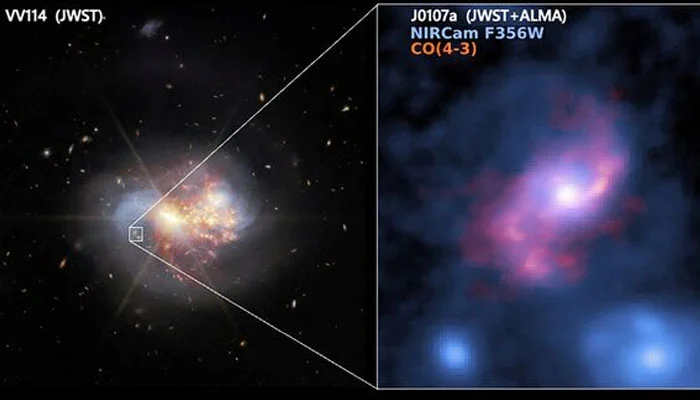Astronomers have made a remarkable observation of a galaxy from an earlier epoch in the universe’s history that surprisingly resembles our own Milky Way—featuring a spiral structure with a prominent, straight bar of stars and gas extending through its center. This newly observed galaxy, however, is far more massive, offering fresh insights into the processes of galactic formation. The distant galaxy, designated J0107a, was observed as it appeared 11.1 billion years ago, a time when the universe was approximately one-fifth of its current age. Researchers utilized data from the Chile-based Atacama Large Millimeter/submillimeter Array (ALMA) and NASA’s James Webb Space Telescope to conduct their study of this galaxy.
Their analysis determined that the galaxy’s total mass, encompassing both its stars and gas, exceeded that of the Milky Way by more than 10 times. Furthermore, it was actively forming stars at an annual rate approximately 300 times greater than our galaxy. Despite its immense mass, J0107a was found to be more compact than the Milky Way. “The galaxy is a monster galaxy with a high star formation rate and plenty of gas, much more than present-day galaxies,” stated astronomer Shuo Huang of the National Astronomical Observatory of Japan, who is the lead author of the study published this week in the journal Nature. “This discovery,” added study co-author Toshiki Saito, an astronomer at Shizuoka University in Japan, “raises the important question: How did such a massive galaxy form in such an early universe?”
While a few galaxies in the contemporary universe exhibit star formation rates similar to J0107a, nearly all of these are currently undergoing a galactic merger or collision. There was no evidence of such circumstances involving J0107a. J0107a and the Milky Way share some common characteristics. “They are similarly huge and possess a similar barred structure. However, the Milky Way had plenty of time to form its huge structures, while J0107a didn’t,” Saito explained.
In the initial few billion years following the Big Bang event 13.8 billion years ago, which marked the universe’s genesis, galaxies were turbulent entities and contained significantly more gas than those existing today. These factors fostered extreme bursts of star formation. While galaxies with highly organized structures, such as the barred spiral shape of the Milky Way, are now common, this was not the typical case 11.1 billion years ago. “Compared to other monster galaxies in the distant universe [dating to an earlier cosmic epoch] whose shapes are usually disturbed or irregular, it is unexpected that J0107a looks very similar to present-day spiral galaxies,” Huang noted. “Theories about the formation of present-day galactic structures may need to be revised,” Huang further suggested.
The Webb telescope, with its capacity to observe across vast distances back to the early universe, has revealed that galaxies with a spiral shape appeared much earlier than previously understood. J0107a now stands as one of the earliest-known examples of a barred spiral galaxy. Approximately two-thirds of the spiral galaxies observed in the universe today possess a bar structure. This bar is believed to function as a stellar nursery, drawing gas inward from the galaxy’s spiral arms. Some of this gas condenses into what are known as molecular clouds. Gravitational forces cause these clouds to contract, forming small, dense centers that heat up and ignite into new stars. The bar within J0107a is estimated to be about 50,000 light-years in length, according to Huang. A light-year represents the distance light travels in one year, equivalent to 5.9 trillion miles (9.5 trillion km). Saito concluded, “The Webb telescope has been studying the morphology of early massive galaxies intensely recently. However, their dynamics are still poorly understood.”



